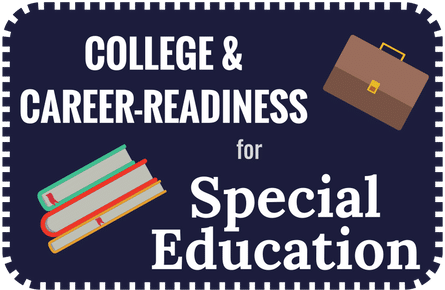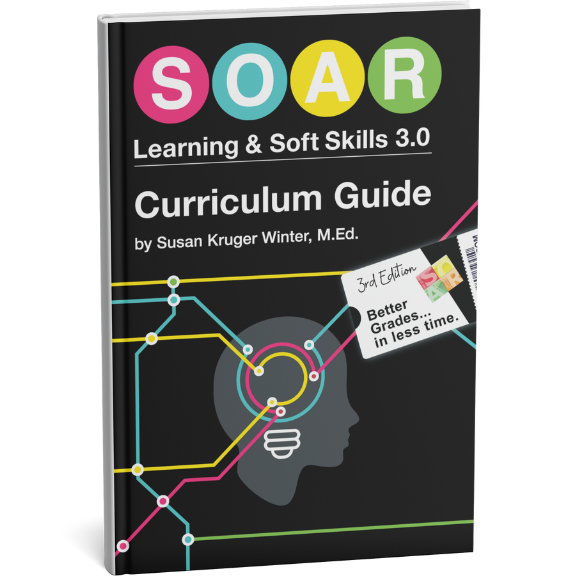College and Career-Readiness for Special Education
“My students think they are ‘broken,’” lamented one special education teacher. “They don’t have dreams because they don’t think their dreams matter.”
The truth is, our education system is not equipped to help any student explore their dreams and options beyond high school. But special education students have an even greater disadvantage; they don’t think they have any options.
As I often say, “What’s best for students in special education, is best for ALL students.” Developing college and career-readiness is no exception. The following blueprint is very simple. Yet, it is critical for mapping all students to success. Especially our special education students!

Five Steps to Success: College and Career-Readiness for Special Education
The following five steps build upon one another. They are critical for building the confidence any student needs to go after their dreams and find success.
Step 1: Know How the Brain Works
My team and I each interviewed several special education teachers.
Overwhelmingly, these teachers agreed their students severely suffered from self-helplessness. “All they know is they are different from other students. They don’t understand anything about their disability. They give up before they even try.”
Tara Wilkins, a special education teacher in Colorado, teaches her students how the brain works. And how their brains work. “I want them to understand their ‘learning disability’ is simply a ‘learning difference,’” she explained.
Tara found this insight was the key to unlock motivation. She taught her students that they weren’t broken; they just needed to build some learning detours.
Carol Dweck, Ph.D, came to a similar conclusion through her groundbreaking research on motivation. Dweck discovered there are types of mindsets: fixed or growth.
A fixed mindset is what most special education students have. They think they are born a certain way and can never change.
A growth mindset is what we want students to have. We want them to believe they can always learn new things. They can change. Their lives can change. They can be successful!
Dweck also discovered that students can switch from a “fixed mindset” to a “growth mindset” by learning how the brain works. Students can learn how their brains work through the following videos:
Step 2: Start with Strengths
Our education system is very good at focusing on what students can’t do. On what they don’t do well.
We must reverse that perspective and start with strengths! We must ask our students, “HOW are you smart?” I like to explore the Multiple Intelligences with students. (Check out our free Multiple Intelligences assessment.)
ANY opportunity students have to learn about their strengths is a valuable investment of time. If you have access to any aptitude inventories, let your students take them!
Step 3: Learn Soft Skills
Employers are complaining about a “skills gap.” Countless sources of data confirm this “skills gap” is the #1 bottleneck in the global economy.1
That gap is about a lack of soft skills. Soft skills include: the ability to communicate effectively, work with others, manage time, and handle responsibilities. One detailed study found that 75% of a person’s success in the workplace is determined by their soft skills. Only 25% of workplace success is determined by their technical knowledge.2
Another study concluded, “Employers are hiring for technical skills, but firing for a lack of soft skills.”3
The good news is, “soft skills” level the playing field for special education students! These skills are accessible to anyone and provide a very competitive advantage.
Step 4: Explore Career Pathways
First and foremost, please understand that college is becoming more and more overrated! Yes, this article is about “college and career-readiness.” That’s only because it’s a trending phase. People are not searching for “post-secondary education and career-readiness.” But, that’s a better description of what we should be exploring.
College is getting more and more expensive. Meanwhile, millions of good-paying jobs that don’t require a college education go unfilled every year. For more details, see the following video:
- Success in the New Economy – A nine-minute video that will radically change the way you think about college.
How do you find options other than college? The answer depends on your location and will require some research. Check with your local county’s Department of Economic Development.
In my home state of Michigan, an organization called MI Bright Future coordinates students, employers, and post-secondary training/education opportunities. More and more of these resources are popping up around the country as the need for a “non-college-educated” workforce grows.
Step 5: Connect Students’ Strengths to Education & Career Options
It’s very important to map students’ strengths and aptitudes to available options. MANY students skip this step. They simply go from high school to college. They hope they’ll figure out a plan as they go. That’s a quick way to waste a lot of time and money. Students should always have a plan before they spend a dime.
I encourage all students to take a gap year. They need real-world experience before jumping into more school… that may or may not be a good fit for their strengths and interests.
Finally, consider support options. There are no laws guaranteeing special support for students after K-12. IEPs and 504s are not applicable in the post-secondary world. However, most colleges and training programs recognize that many students need additional support. Once students have identified options that are of interest to them, they should explore available options for support.
Regardless, students must know how to advocate for themselves. And that brings us right back to Steps 1-3 of this process: know how the brain works, start with strengths, and learn soft skills.
When Should College & Career Planning Begin?
What do you think is the best time to begin the planning process? Tenth grade? 11th grade?
The optimal time is as early as 6th grade. (Although, it’s never too late! Always better to have a plan than no plan.)
Sixth grade is the time when students start looking beyond their own world. It’s the time they start asking, “Why do I need to know this?” It’s the time they start questioning their abilities and their self-worth.
The earlier students can develop an understanding of how their brain works (Step 1) and develop a solid appreciation for their strengths (Step 2), the less friction they will face on their path to success. Research shows that the middle school years are the critical tipping point for students.4 This is especially true for students with special needs. If students struggle in middle school, high school will only be more challenging.
The middle school years are the optimal time to develop soft skills. These skills will empower them to advocate for themselves and navigate all their options.
Middle school is the time self-confidence becomes crippled when they don’t have the soft skills to manage the communication demands and responsibilities of school.
Middle school is also the time that motivation begins to wane. However, students thrive when they are encouraged to explore options and dream beyond the walls of school.
Conclusion
The process of developing college and career-readiness for special education students is no different than for any student. The optimal time to start the process is in sixth grade. But, it’s never too late.
The five steps include:
Step 1: Know how the brain works.
Step 2: Start with strengths. School is naturally good at identifying what students don’t do well. They must seek to recognize their own strengths.
Step 3: Learn soft skills. Soft skills level the playing field for students with learning disabilities. These skills are accessible to anyone… and they are in desperate demand from employers!
Step 4: Explore career pathways. Don’t assume that college is the best answer. In today’s economy, there are dozens of very good paying jobs that don’t require college. In fact, many students who have a college education are overqualified for the positions they hold… and in a lot of debt! Take some time to research in-demand jobs and all education options available to you.
Step 5: Connect your strengths to education and career options. Most students don’t take the time to match their strengths and interests to available options. It’s takes a little time to do the research and plan, but it is truly the investment of a lifetime.
With a little bit of planning and whole lotta confidence, every student with “learning differences” can discover success!
Want a simple and engaging way to develop soft skills? See our SOAR® Learning & Soft Skills software app, here.
To our students’ success,
Susan Kruger Winter, M.Ed.
Author of the worldwide best-selling program, SOAR® Learning & Soft Skills
Founder of StudySkills.com
Former Struggling Student
Sources
1 https://studyskills.com/educators/what-students-and-employers-both-need/
2 Abbas, Kadir, & Azmie. “Integrating Soft Skills Assessment Through Soft Skills Workshop Program for Engineering Students at University of Pahang: An Analysis.” International Jo2 urnal of Research In Social Sciences Vol. 2, No.1 (2013): P. 1.
3 http://www.semcog.org/desktopmodules/SEMCOG.Publications/GetFile.ashx?filename=LifelongSoftSkillsFrameworkApril2012.pdf
4 https://www.amle.org/portals/0/pdf/articles/policy_brief_balfanz.pdf
Six Steps
Conquer the Chaos
Get Our Free Guide & Information on...
 How to Organize & Motivate Students for Success
How to Organize & Motivate Students for Success
"*" indicates required fields
Get Our FREE Curriculum Guide!
The SOAR® Curriculum
The most critical learning, organizing, and communication skills needed for school. Learn more here.
Who’s Using SOAR®?
SOAR® Guarantee
Click here to learn more.





